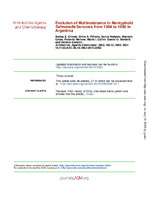Por favor, use este identificador para citar o enlazar este ítem:
http://sgc.anlis.gob.ar/handle/123456789/196| Título : | Evolution of Multiresistance in Nontyphoid Salmonella Serovars from 1984 to 1998 in Argentina | Autor : | Orman, Betina E. Piñeiro, Silvia A. Arduino, Sonia Galas, Marcelo F. Melano, Roberto Caffer, María Inés Sordelli, Daniel O. Centrón, Daniela |
Palabras clave : | Salmonella;Evolución Molecular;Resistencia a Medicamentos;Argentina | Fecha de publicación : | 2002 | Descripción : | Molecular evolution of multiresistance in nontyphoid Salmonella spp. was investigated with 155 isolates obtained in Argentina from 1984 to 1998. In 74 isolates obtained from 1984 to 1988 resistance was associated with the presence of Tn3, Tn9, class I (In0) and II (Tn7) integrons, and the aac(3)-IIa gene. Extended-spectrum cephalosporin (ESC) resistance in Salmonella spp. emerged in 1989, and 81 isolates resistant to at least one ESC and one aminoglycoside were collected thereafter. Among these, two patterns of antimicrobial resistance mechanisms were found: from 1989 to 1992, resistance was related to the spreading of Tn1331 and blaCTX-M-2, in addition to the persistence of In0 and Tn7. From 1993 to 1998, several integrons were added to the first pattern and three integron groups (IG), namely, IG1 (38% of the isolates), IG2 (51%), and IG3 (11%), were identified. At least two -lactamase genes were detected in 65% of the isolates (after 1989) by PCR analysis. Furthermore, five -lactamase genes, blaCTX-M-2, blaOXA-9, blaOXA-2, blaTEM-1, and blaPER-2, were found in two isolates. The blaCTX-M-2 gene was found in several complex sulI-type integrons with different rearrays within the variable region of class I integrons, suggesting evolution of these integrons in nontyphoid Salmonella. In conclusion, progressive acquisition and accumulation of plasmid-mediated resistance determinants occurred from 1984 to 1998 in nontyphoid Salmonella isolates of the most prevalent serovars from Argentina. It is suggested that antimicrobial resistance mechanisms in these bacteria may have been the consequence of plasmid exchange between Salmonella enterica serovar Typhimurium and Escherichia coli or Shigella flexneri and/or spreading of mobile elements from the nosocomial environment. Fil: Orman, Betina E. Universidad de Buenos Aires. Departamento de Microbiología; Argentina. Fil: Piñeiro, Silvia A. Universidad de Buenos Aires. Departamento de Microbiología; Argentina. Fil: Arduino, Sonia. Universidad de Buenos Aires. Departamento de Microbiología; Argentina. Fil: Galas, Marcelo. ANLIS Dr.C.G.Malbrán. Instituto Nacional de Enfermedades Infecciosas; Argentina. Fil: Melano, Roberto. ANLIS Dr.C.G.Malbrán. Instituto Nacional de Enfermedades Infecciosas; Argentina. Fil: Caffer, María Inés. ANLIS Dr.C.G.Malbrán. Instituto Nacional de Enfermedades Infecciosas; Argentina. Fil: Sordelli, Daniel O. Universidad de Buenos Aires. Departamento de Microbiología; Argentina. Fil: Centrón, Daniela. Universidad de Buenos Aires. Departamento de Microbiología; Argentina. |
URI : | http://sgc.anlis.gob.ar/handle/123456789/196 http://aac.asm.org/content/46/12/3963.full.pdf+html |
ISSN : | 1098-6596 | Derechos: | info:eu-repo/semantics/openAccess |
| Aparece en las colecciones: | snrd Publicaciones INEI |
Ficheros en este ítem:
| Fichero | Descripción | Tamaño | Formato | |
|---|---|---|---|---|
| AntimicrobialAgentsandChemotherapy,2002,46(12),3963–3970..pdf | 230.96 kB | Adobe PDF |  Visualizar/Abrir |
Visualizaciones de página(s)
169
comprobado en 29-nov-2025
Descarga(s)
115
comprobado en 29-nov-2025
Google ScholarTM
Consultar
Los ítems de DSpace están protegidos por copyright, con todos los derechos reservados, a menos que se indique lo contrario.

